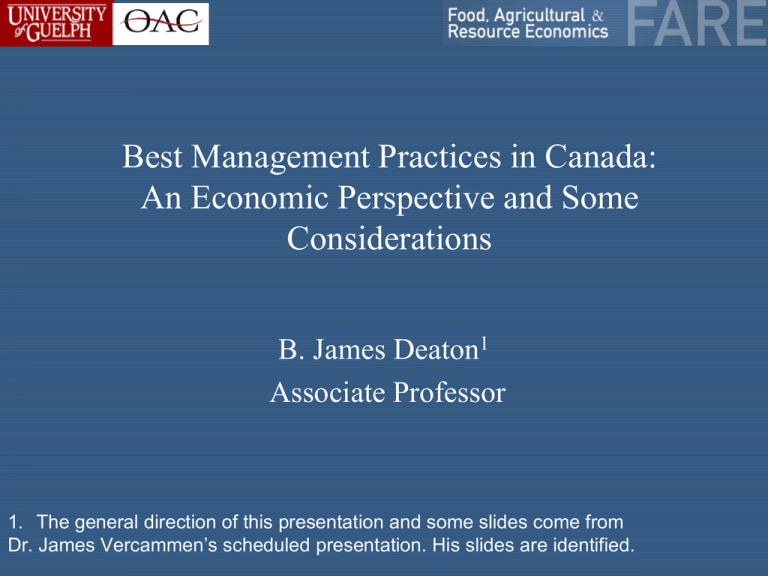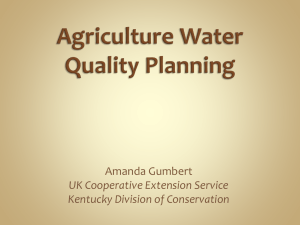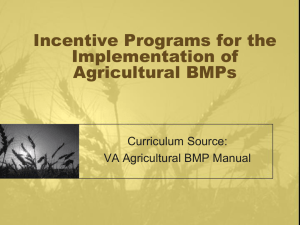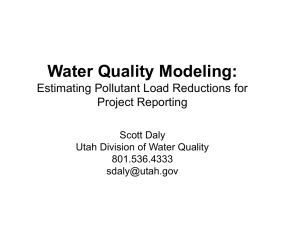The effect of Ontario*s Greenbelt on the value of vacant farmland
advertisement

Best Management Practices in Canada: An Economic Perspective and Some Considerations B. James Deaton1 Associate Professor 1. The general direction of this presentation and some slides come from Dr. James Vercammen’s scheduled presentation. His slides are identified. AAFC & OMAFRA • “A profitable and innovative agriculture, agri-food and agri-based products industry that seizes opportunities in responding to market demands and contributes to the health and well-being of Canadians.” AAFC Growing Forward Vision Statement • OMAFRA definition of BMP: “A practical, affordable approach to conserving a farm’s soil and water resources without sacrificing productivity.” http://www.omafra.gov.on.ca/english/environment/bmp/series.htm BMP Policy • Federal & Provincial – e.g., (COFSP) • AAFC & OMAFRA • – Administration & Implementation • Ontario Federation of Agriculture • Ontario Soil and Crop Improvement Association Process for eligible producers – Environmental Farm Plan (EFP) – Cost-share funds for projects • Examples: – Runoff controls • e.g. Diversion around farmyard operations. • Constructed wetlands – Buffer establishment in riparian areas – Fencing – Windbreaks – Precision Agriculture (GPS) – Anaerobic Digester V James Vercammen Market System & Externality Adam Smith A.C. Pigou Ronald Coase Questions • The effect of BMP on net-farm income? – Increase – Reduce – Neutral • Cost-Effectiveness – How to target to maximize net-benefits to society? 1. See The Porter Hypothesis at 20: Ambec, S., M. Cohen, S. Elgie and P. Lanoie BMP Adoption and Farm Profitability • L. Valentin, D.J. Bernardo, Kasten. 2004. Review of Agricultural Economics – Nutrient BMPs had a positive effect on net farm income – Herbicide BMPs had a negative impact on income. Is Federal Government Expenditure on BMP Cost-Sharing Cost-Efficient? • As of 2008 Federal government has spent $175 million on 43,000 projects (more than 25% were GPS Cropping Systems on the Prairies). • Would the farmer have purchased a GPS-based cropping system without program? • Targeting difficult due to farmer heterogeneity. James Vercammen Watershed Evaluation of BMPs (WEBS) • WEBS (initiated by AAFC in 2004) measures the effectiveness of BMPs designed to reduce nutrient seepage into waterways. • BMPs include fencing waterways, conservation tillage and containment pods. • BMPs are found to be environmentally effective but generally provide a low private return. James Vercammen Targeting Considerations James Vercammen James Vercammen Farm and non-farm population in Canada, 1931 to 2006 Source: Statistics Canada (http://www.statcan.gc.ca/pub/16-201-x/2009000/ct045- 15 Who is the other? % of Rental Land by Landlord Category 2 4 5 16 10 19 7 Active Farmer Retired Farmer Widow(er) Rural Residence Owner Invest Invest Company Government none of the above 36 16 Observations 392 Research conducted with James Bryan and A. Weersink Riparian Buffer Case Study • A riparian buffer is vegetation that separates farmland from a waterway • The buffer reduces the seepage of nutrients such as manure from the land into the waterway • AAFC combined data from 2006 Farm Environmental Management Survey (FEMS) with 2006 Census of Agriculture data • The survey asked the following question: “Do you maintain a riparian buffer area around permanent wetlands?” James Vercammen James Vercammen











